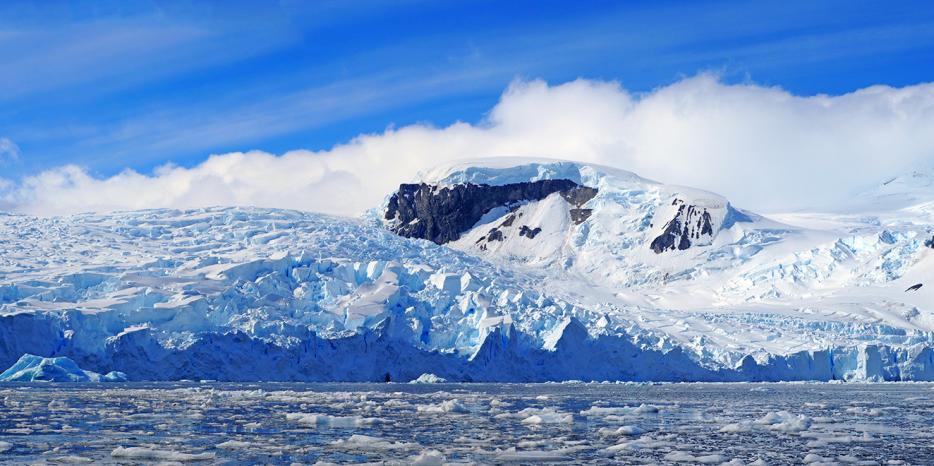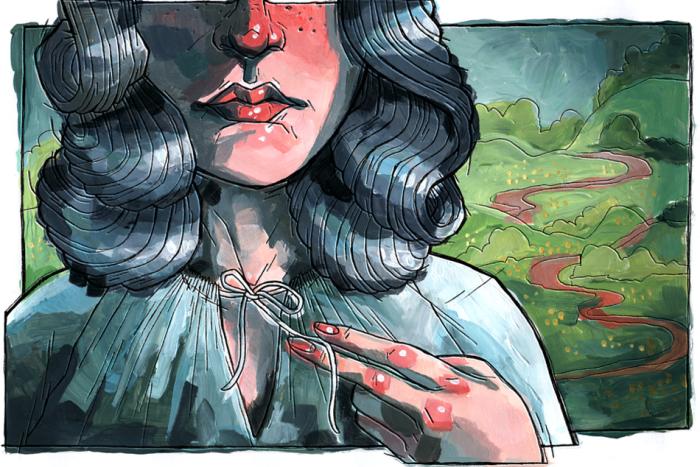Antarctica is cold, but it’s not the coldest I’ve ever been.
The worst cold befell me shortly after I moved across the country, from New York City to Seattle, Washington, nearly a decade ago, just as the year turned over. It wasn’t the northwest winter, which barely earns the right to call itself brisk. That February, I came down with a fever, red-hot and unremitting, some nameless virus announcing itself to my immune system. I threw up. I hallucinated my tattoos dancing off my skin. Only installing myself inches from a gas fireplace under no fewer than four blankets and adhering to a religious regimen of antipyretics could pause the shivering that transformed my body into one long groan.
Eventually, the fever broke, and I surfaced to lucidity. But I think it left a psychic mark. That kind of cold is less a sensation than a discrete emotion, a shouting need to feel any way else. Feeling that bad leaves a residue of fear for the feeling’s return. For years after, I dressed warmer than the weather required, accumulated blankets in my home, suspicious of an unheralded, invading chill.
Still, in January of 2017, I spent about 30 hours in air transit and nine days on a small cruise ship, the MS Hebridean Sky, in pursuit of seeing what was to be seen at the bottom of the world, where the coldest temperature on Earth was recorded (minus 94.7 degrees Celsius, in 2010).
The second coldest I’ve ever been was while trying to run, but in fact stumbling, into the waters of an Antarctic caldera wrapped in the arms of Deception Island, in the South Shetlands. The volcano last erupted in the 1970s, damaging nearby science stations. Long before that, the area was a whaling village. Rust-colored oil tanks dot the island’s edges like a Richard Serra installation, flanked by decrepit houses, piles of shattered wood barrels, traces of primitive graveyards, and the remains of a whaling vessel. In the other direction: whale skeletons, biblical and anatomic, great vertebral chains, left over from a time before whalers discovered bones were oil-rich, too.
It’s a grimmer setting than I had pictured for our vaunted “polar plunge.” I had imagined slipping off a little platform on the stern of the ship, the winter version of a Caribbean snorkel, propelled by only a split-second will to jump, gravity picking up the rest of the tab. Instead, we strip down to bathing clothes on a rocky beach—beach is a generous word—and propel ourselves, step by step, into the water, determined to have done with it.
We wade through a layer of sulfurous steam along the coastline, warmed by subterranean hot springs. Then: the slap of frigid water, brutal, the kind of cold that makes you believe you will never be warm again. On this, the single overcast day of our voyage, the cool air offers no relief. I swim a few strokes, hoping to encourage circulation. On shore, wiser, drier travelers wave encouragement. I have to put my head down, I think, get my hair wet, or I won’t feel I’ve really done it, haven’t committed. I have to submerge all the parts of me into this gesture. For a moment, I duck under the surface and the world goes numb and quiet. Everything external fades into irrelevance. Just for a moment.
* * *
Here are some facts. Antarctica remains the only continent on Earth not permanently inhabited by humans. In 1911, the Norwegian explorer Roald Amundsen led the first expedition to reach the South Pole. In 1959, after many more incursions, the establishment of the Antarctic Treaty System preserved the continent as a neutral and peaceful area of scientific discovery. Today 30 countries have research stations there, the only place in this world far from the madding crowd, unowned and unguarded.
Here is another fact: the Antarctic is impossible to describe and pictures cannot do it justice.
It takes two days’ sail to reach Antarctica. We leave the port town of Ushuaia, traverse the Beagle Channel, named for Darwin’s ship, and then we are in open water. An albatross tails us all the way from Argentina to the peninsula, an enormous, white-winged blur, diving ostentatiously around the ship, a benediction straight out of Coleridge. A Tristan's albatross, not a wandering albatross, says one of the guides, an Australian ornithologist. I am unable to remember which one blessed (then cursed) the ancient mariner.
Seasickness eclipses the anticipation of arrival for me. I spend most of the first full day in bed, at first too nauseated, then too blitzed on Dramamine to do anything else. The boat pitches back and forth like a drunk. So much for the state-of-the-art balancers with which the Hebridean Sky has supposedly been retrofitted. Tiny for a cruise ship, the HS can accommodate 120 passengers in 59 cabins. Larger ships are not allowed in Antarctica. IAATO, the International Association of Antarctic Tour Operators, delimits the volume and spread of visitors to the continent, so as not to hasten the anthropogenic destruction already guaranteed by global warming. Somewhere around 40,000 tourists visit each year. I’m not sure there are many more trying to break down the door. It is far away, and it is expensive.
By day two, the Drake Passage has settled, and I venture outside the cabin to take in the edgeless, white capped waters. It is the first time in my life I have been unable to spot land on any horizon.
* * *
It’s not that I divide my life into the periods before and after I went to Antarctica, exactly. It’s more that the trip occurred during and in some ways accelerated a gradual change that has been happening all my life. I was, in a few words, moving inward, away from the world and toward myself. Perhaps this shift is universal, the logical conclusion of self-object differentiation. Maybe it’s the result of a life lived in too many thin-walled apartments. Maybe it’s just what happens after a certain amount of heartbreak. I don’t mean to suggest that something calamitous happened which impelled me to seek out the kind of extremity Antarctica embodies. It didn’t. I went because my mother, an inveterate explorer, asked me if I would like to go with her.
It’s hard to describe going in search of an absence. But, in a way, that’s what I was doing: trying to find that innermost part of me impermeable to loneliness and loss, what T. S. Eliot called “the still point of the turning world,” where everything pauses and gives way to a perfect inertia. I didn't expect to find it—but then, it’s the sort of thing that’s found incidentally in the pursuit. I sensed I might find that salutary emptiness within by seeking emptiness without. It is hard to imagine a place more bereft than the polar South.
During this time, in this faraway mood, I read a host of books about vast spaces, person-less places, the cold. Places of absence. Strangely, post-Soviet literature seemed right: Snow in May, a lovely collection of short stories by Kseniya Melnik, who immigrated from northeast Russia to Alaska, and whose stories are all set in her hometown of Magadan which used to be the way station for prisoners en route to Stalin’s camps; Vladimir Sorokin’s bizarre and eerie Ice Trilogy; The Slynx, by Tatyana Tolstaya, Lev Tolstoy’s granddaughter, a harsh, satirical novel about a post-apocalyptic landscape clearly meant to comment on the absurdity of human society. In these books, meaning ceases to have meaning. Cause does not lead to effect. Life is arbitrary, surreal, and casually cruel, just as it was after the fall of communism in Russia. If communism demanded sacrifice, at least it made a certain austere sense. It was for the good of the country, the good of its collective people. But after 1992: splintering, hardship, chaos. The organizing principle of a massive state upended, just like that. Only the long, hard winter reminded you where you were.
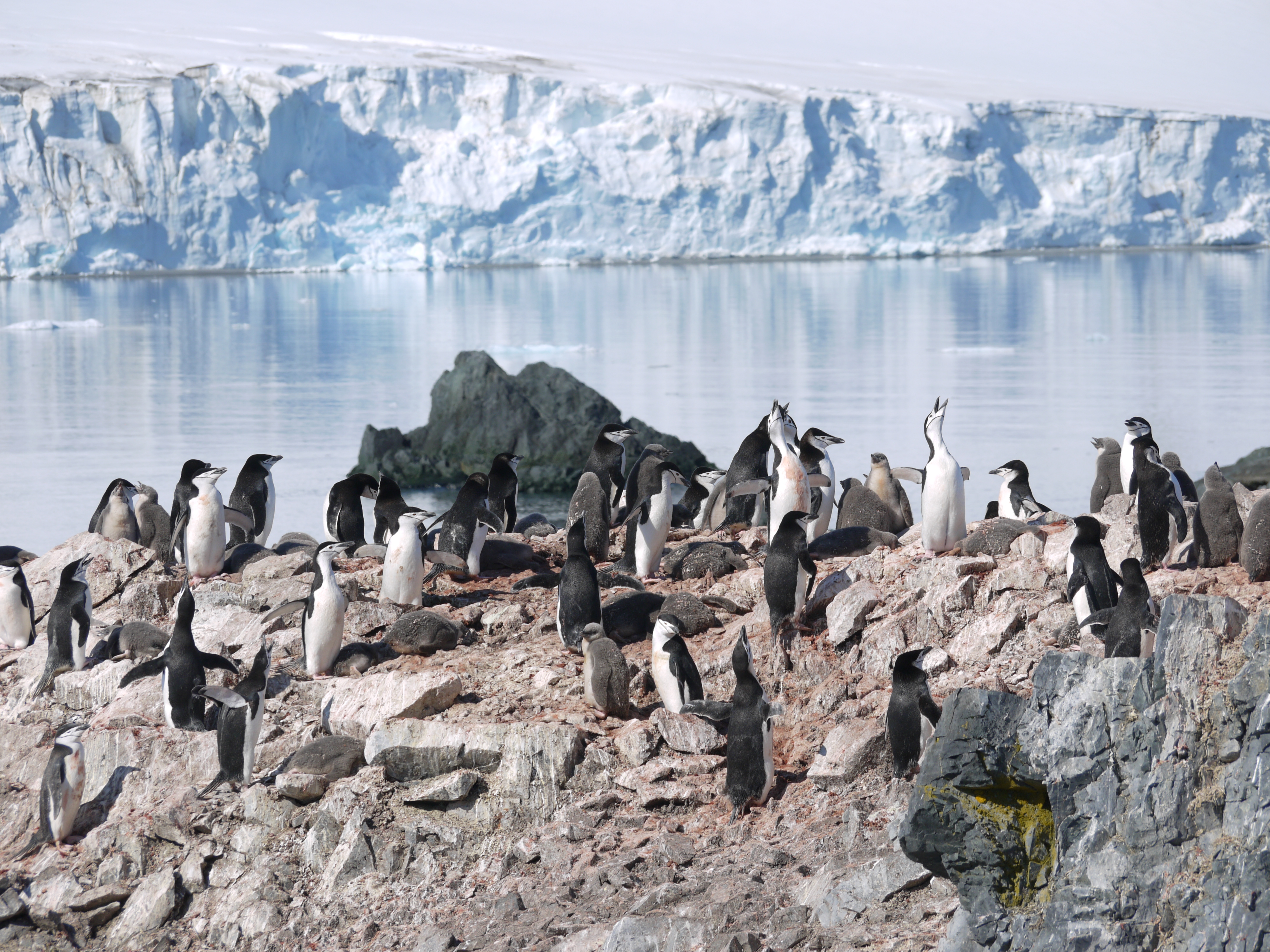
This is also the period when the work of the writer Gretel Ehrlich came into my life. In 1978, California native Ehrlich precipitously moved to rural Wyoming and became a cattle rancher, enduring social and geographic isolation, and a brutal climate. Here she wrote her first and best book of essays, The Solace of Open Spaces, rendering life among the animals, and her turns of mind and heart. Prone to choosing hardship over comfort, Ehrlich went on to spend many seasons in Greenland, of all places, embracing the winter desolation and darkness of the far North. About this time she wrote This Cold Heaven, a hybrid chronicle of her experiences and early history of the land.
Erlich’s voluntary privation obsessed me. I felt a kinship with her desire to break away from the balms and gratifications of quotidian existence, to, as Thoreau put it, “front only the essential facts of life.” But she had actually pulled the escape hatch. I knew I never would. I tend to idolize the monastic lifestyle Ehrlich found—the unerring commitment and seriousness of it, the way no time is wasted in frivolities—but I lack the discipline and impulse control. The best I could do was live it in words, a vicarious stoicism.
* * *
Early in the third morning aboard the HS, expedition leader Hailey’s New Zealand lilt, bright as the polar sun, cuts through our cradle-rocked sleep. Go outside, she says, with urgency.
I will try to tell you what we saw that morning, and each day for the next week, but I will fail. All I can hope for is an asymptotic kind of evocation.
The most common description of Antarctica is that it looks like an alien planet, and that is true. It is true not only because of Antarctica’s distance from the known world, but because of its unfathomable scale. One’s puny human systems of measure and value fall by the wayside. Scales geologic and planetary reign. Its ingredients are familiar and elemental—ice, sea, air, cloud—but they conspire to form an exotic whole, utterly foreign to the incidental visitor.
Over the course of the week, we learn the aesthetic pendulum swings of the place.
In the days, a blinding brightness overlays shimmering bands of water in every direction. It is summer—you can only visit Antarctica in summer—and a cloudless blue canopy lords over the landscape. The sea is a great silvery glass of ice water, celebratory like a cocktail, poised in the moment before it is slung back and drunk. It splashes unhurried onto calm peninsular shores. The land cuts a sliver between sea and sky, a seam stitching the world together. Its snow drifts sail and swoop across the horizon. Smooth surfaces belie the violent storms that made them. The scene makes for an almost lurid vista, highlighting an excess of cool tones, neon reflections necessitating the use of sunglasses. A painter would be accused of exaggeration.
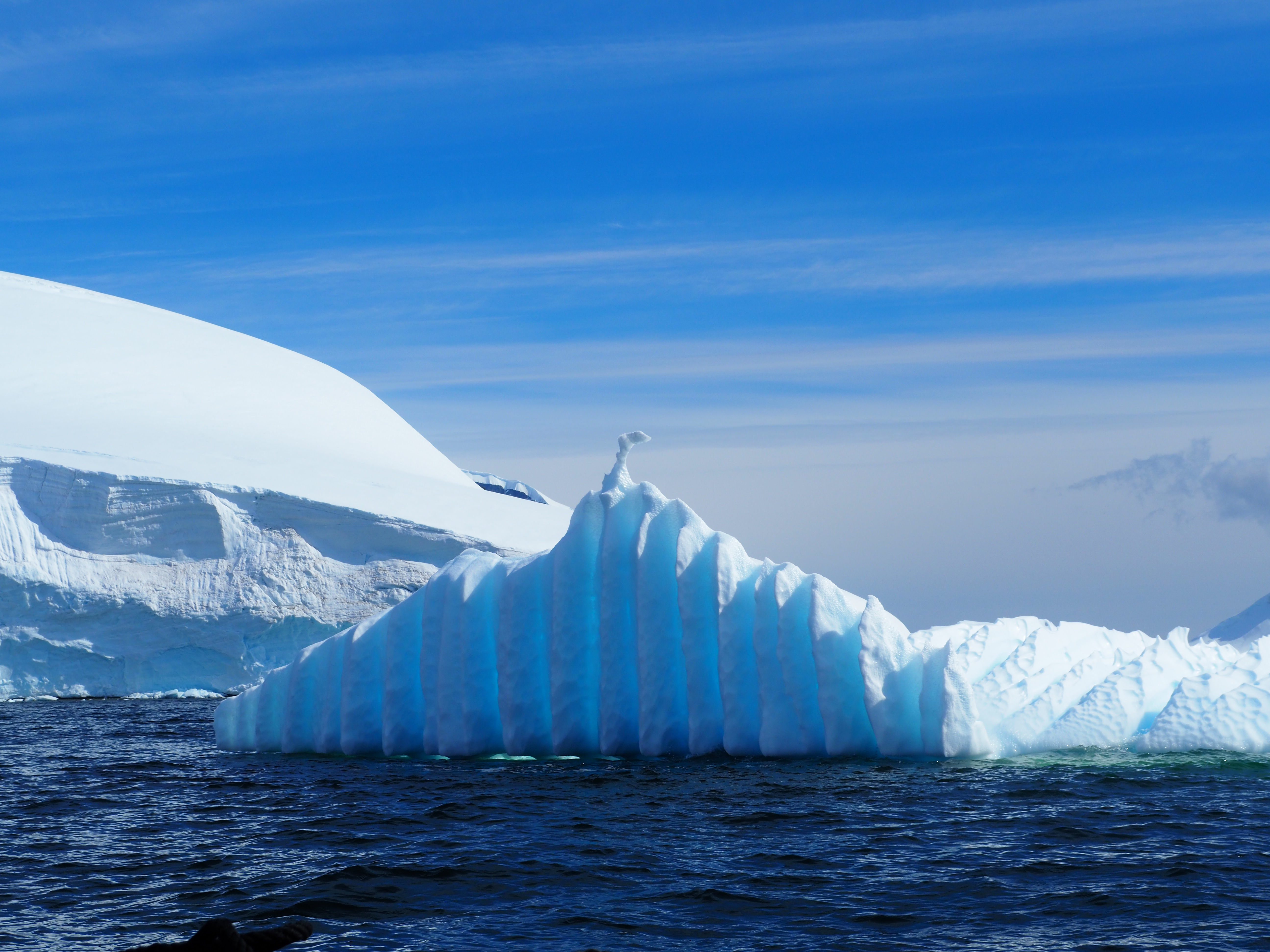
Before leaving and upon returning to the ship, we rinse our boots in a cleaning solution, which feels symbolic. We drive from the HS to shore in small motorized rafts called Zodiacs and walk from the shallows to dry land. There we see penguins for the first time, and countless times after, great, teeming colonies of black and white and gray-brown chicks. We note the absence of moisture in the air, its ubiquity on the ground. A surprise: Antarctic summer feels like a balmy week of Northeast winter, low to mid-thirties Fahrenheit each day, the sun beating down unhindered. Our first expedition off the ship teaches me I have worn too many layers: a thermal skin, insulated snow pants, a stretchy shell, a fleece, and a ski jacket. Five minutes on land sees the coat tied around my waist, leggings stuck to the insides of my knees.
At night, the sky is a watercolor wash. Sunset tries to push in but day resists, never giving over to real darkness, instead smudging the blue over the glaciers peach and mauve. Waterfalls of glacial rock glow rose and coral in the perma-dusk. Clouds roll in just to catch the pinkish light. Distant peaks are scoops of sorbet. Everything seems impossibly far apart, held together precariously in any moment by the eye, always about to drift even farther.
In Antarctica, the calendar year, quartered into seasons like a twice-sliced pie, looks like the artifact of a strange civilization. The continent follows the logic not of four but of two: of light (October to February) and dark (March to September). Light and dark, mirror to the human psyche, and like the human psyche, slightly favoring dark over light. Not multiplicity but dichotomy.
The Midnight Sun prevails yet I feel sleepy all the time. I tumble into bed each night unreasonably wiped, fall into sleep like a meteor hitting the Earth. Maybe it's the constant soft rocking of the ship, like being in utero. At night I lie in bed, back on the HS after a day of trekking the continent, listening to the ship's joints complain of the thrashing waves. It sounds like the water has grown fingers and is trying to punch through the hull. Foam scrabbles at our porthole. At times the HS lifts me bodily from my repose, a gentle reminder of who is in charge here.
* * *
Searching for a salutary alienation in Antarctica has the whiff of the absurd about it, when you consider the kind of mass-scale, coordinated human enterprise it takes to get you there, not to mention that you can pretty much only go with a bunch of other people. A tour company coordinates the logistics, then delivers you an itinerary like a school chaperone, demanding obeisance to parliamentary procedure and time table.
You also can’t go very far in, at least not as a casual visitor. Steep glacial cliffs thwart maritime access to most of the Antarctic, so tours confine themselves to the peninsula, a tail curling off the continent toward South America.
Once we arrive on Antarctic soil, there can be no doubt: we are an invasive species, a flock of flailing, red-jacketed warblers whom the natives sanction with benign neglect (having no reason to fear us, penguins amble past at knee-height, indifferent to our comings and goings). Camera shutters open and close like bird beaks. Antarctica is a photographer’s paradise, all shapes and shadows playing across the firmament. Some of my fellow travelers walk the ice with small fortunes of photography equipment in tow.

Even the crunching of my own boots grates. Quiet must be stalked like prey. Wishing everyone else away at all times, I adopt strategies on expedition for tuning them out: focus on the three-foot radius around me; lock eyes with a tern perched a little ways away; find a quiet outcropping to rest, preferably over a hill from the main action. I like to sink a foot or two into a soft snow bank, coming to rest with my eyes almost at ground height. Disappearing myself into the land like this, I notice more. Slick penguin feathers pierce the surface of the shallow water near shore. A massive rock reveals the taupe hide of a hulking, smug-faced elephant seal who drowses in the heat of the day.
Often, I pass an hour or two in this way. Other tourists mostly respect the wishes of those wanting solitude, so I am left to my own thoughts, and leave others to theirs, regrouping now and then to marvel as a gang at our extraordinary good fortune. I am never bored, only idling at a slightly quieter level of consciousness than usual, which lends a certain plainness and clarity to my thinking, stripped of what Ehrlich called the “ornamental” in us.
At times, the openness of my surroundings leaves me feeling small and lightheaded, like I might hot-air-balloon into the ether. The philosopher Gaston Bachelard equates snug, confined spaces with personal history. For him the fundamental unit of selfhood is the house, the first place we occupy, and therefore possess forever, because it holds our memories, which we return to over and over like a protective shell that reminds us who we are. “If one were to give an account of all the doors one has closed and opened, of all the doors one would like to re-open,” he writes, “one would have to tell the story of one's entire life.” In other words, the story of one’s self. What, then, of a place without any doors or rooms for hundreds of miles? A space like that might vanquish the self, lift the weight of our memories from our shoulders.
* * *
But this land, wide and strange though it be, is far from empty. In fact, entertainments abound for those who would take notice. Observation—sincere, prolonged observation—is a form of meditation, the oldest trick in the book for mastering the whims and vagaries of the ego. Paying close attention means leaving the self behind, inhabiting Emerson’s transparent eyeball. Eliot considers this the ideal practice of the artist, who engages in a “continual surrender” of the self to the tradition which flows through it. We are each, after all, the artist of our own life.
Ehrlich puts it another way. “Keenly observed,” she says, “the world is transformed. The landscape is engorged with detail, every movement on it chillingly sharp. The air between people is charged. Days unfold, bathed in their own music. Nights become hallucinatory; dreams, prescient.”
A circus of animal life surrounds our staid human party, putting on a nonstop show of labor and play. There are, of course, the penguins: the saffron-beaked gentoo, the bleating Adélie, the chinstrap, so named for the black-colored line under its head. Penguins trill to their mates, clown-honk, squeak, occasionally purr. Overhead, winged critters—albatross, petrels, skuas, cormorants, sheathbills—mock their land-bound rivals. We see Antarctic and Arctic terns. Arctic terns spend summers here and in the Arctic, at opposite times of year, perpetually circumnavigating the globe. They see more daylight than any other creature on Earth.
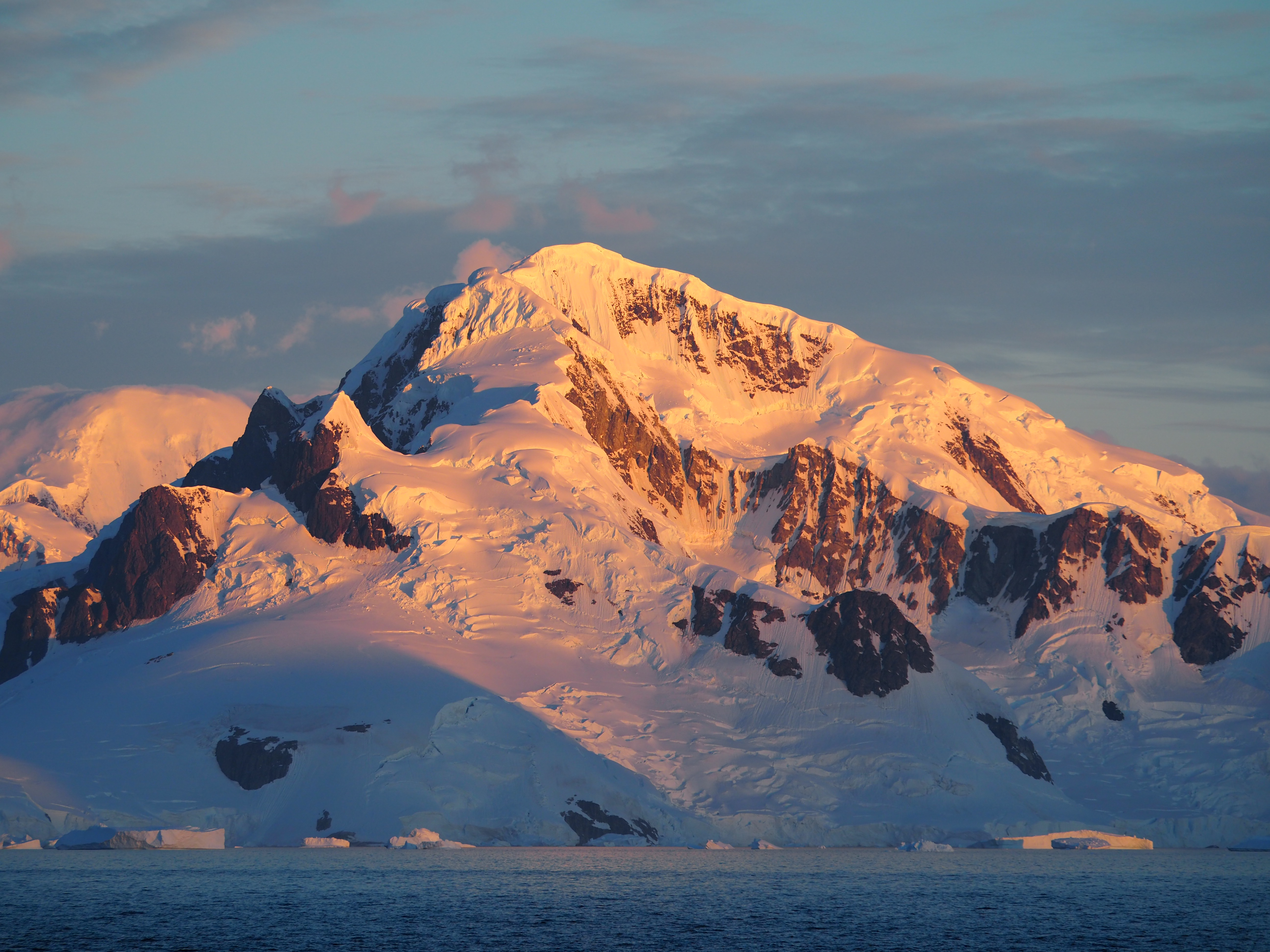
Seals loaf on beaches and accompany our Zodiac voyages, swimming circles around the rafts, poking their heads up for a teasing glimpse. There are elephant seals, fur seals, leopard seals, golden-hued crab-eater seals, Weddell seals, whose eponymous discoverer, James Weddell, in 1823 sailed further south than any explorer before him, and of whom Wikipedia helpfully notes, “He is one of the very few human beings to have a sea named after him.”
But the creatures that draw us in crowds out of our heated cabins and dining rooms and libraries onto the frosty outer decks are the whales: humpbacks, sei whales, minkes. On the HS, the captain keeps watch from the bridge, alerting passengers to sights of interest as we pass. One evening, he advises whales are nearby, and the crew decides to open a front area of the ship not normally accessible to passengers. We huddle together against the wind, squinting into the horizon, and minutes later an orca erupts from the water mere feet from the prow. A collective gasp goes through our makeshift audience. The white-bellied giant seems to pause, mid-breach, before crashing back into the rough seas. The staff start jumping and hugging, which we take as a sign we’ve seen something special and rare.
We imagine, startled into silence, that we can still hear our showy friend under the water. But perhaps it’s just the ever-present birds, diving and squawking, chittering into the wind.
* * *
Any place is loud if you quiet down enough. Even the ice here declares itself. Bergs can be heard grumbling in the deep, air bubbles burbling to the surface from within. Glaciers calve like a long, low cannon shot, or a warning.
Bit by bit, we absorb the complex taxonomy of ice. We learn to speak and read it, coached by the expansive knowledge of our expedition guides. Fast ice is sea ice still attached to land. Glacial ice is like the human psyche: many-layered, difficult to penetrate, at times under great pressure; the pressure is what turns it blue. Every hole in the glacial ice means something. A more circular one is probably a meltwater channel (where water flows through in summer); some are just crevasses that have come to the front of the glacial sheet. Black ice is very old, the result of compressed air. Its perfect clarity reflects water, which makes it invisible to boats, and therefore dangerous. Its surface looks like scales, or the outside of a golf ball, apparently formed by eddies that occur when salt and fresh water mingle. When we run into black ice, we heave a great, gleaming hunk into the floor of the boat to break up for our drinks later.
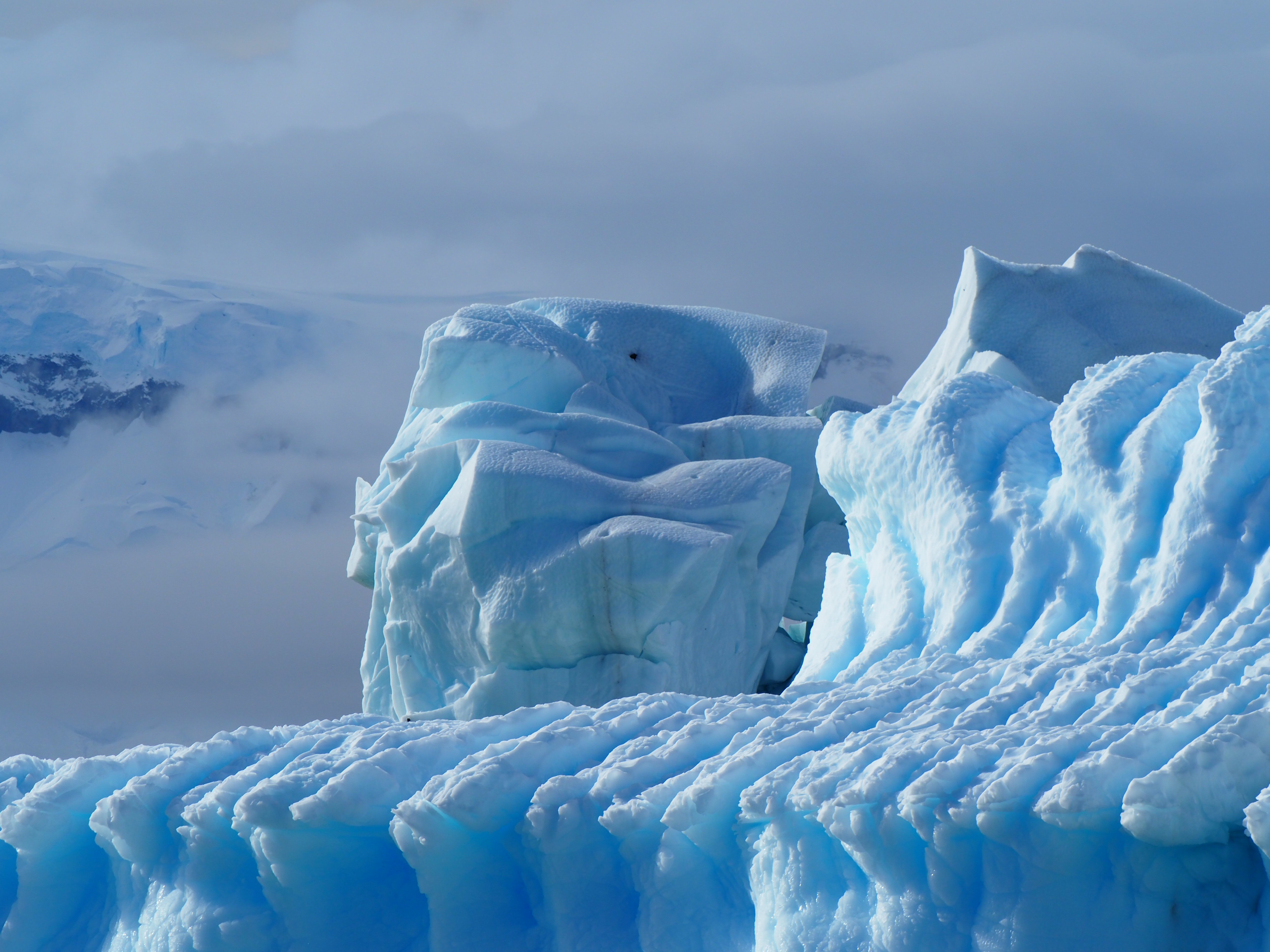
Ice is elementary, the atom of the polar south, constantly shifting and reshaping, breaking apart and combining with bonds weak and strong, birthing and sinking and crumbling. The ice declares that we are all also formed from the same stuff made and remade into different shapes. What appears to be stasis reveals itself as continual motion.
The stars of the show, of course, are the icebergs. The pressure of snow on the glaciers causes icebergs to break off and land in the water. Some cluster in groups, shimmering like pennies dropped into a fountain. Others hulk on their lonesome, like a cathedral in the desert. Icebergs feature whorls, scratch-like marks, pinholes straight through. Jagged edges facing up means they probably fell that way; smooth edges up means they have probably flipped at some point (the submerged side was worn down by the water). Vertical lines through the ice are caused by air bubbles escaping. Icebergs range in color from starkest white to eggshell blue to icy teal.
They look like pillows, coral, tables, piano keys, a dog howling, a wave curling up out of the sea, a row of ill-formed teeth. I could happily cruise around the Antarctic iceberg-spotting for a week. Cloud watching will never hold interest again.
Late in the week, we take a Zodiac cruise to Spert Island, across a turquoise bay then through a spectacular narrow channel flanked by sheer rock cliffs made of igneous rock that has been smoothed down by glaciers. Caves at the bottom of the cliffs, just above the water’s surface, invite speculation. How deep do they go? What lives inside them? On the other side of the channel, swells from the Drake Passage make the water violent, threatening to throw us from our craft. Being the kind of person who loves airplane turbulence, I enjoy this brush with real danger.
I prefer to be at sea-level, on our knees before the sublime, even if we make a more direct target for wind off the water. That day, the harsh, chill air scrabbles at our noses and cheeks, any piece of exposed skin it can sink its claws into. We don scarves and ski gloves, which make picture-taking an elaborate dance. The mild discomfort feels appropriate to the occasion; I lean into the cold. “Part of the ache we feel is also a softness growing,” writes Ehrlich.
* * *
It’s a curious fact that I seem to experience Antarctica more now than when I was there. The remove of time and space has somehow brought me closer to my days on the ice. I recall pleasant superficialities. The zero-percent humidity polar desert blessed me with a tan and perfect hair. My chronic migraines mysteriously quiesced. Here I sit, in my warm home, with a dull ache for this strange, inhospitable place, whose allure has only been enhanced by distance. Antarctica seems like it has a secret or is a secret, and I am still trying to figure out what it is.
I am what the essayist André Aciman calls a “psychological temporizer–who defers, denies, disperses the present, who accesses time (life, if you wish) so obliquely and in such roundabout ways and gives the present so provisional and tenuous a status that the present, insofar as such a thing is conceivable, ceases to exist, or, to be more accurate, does not count.” I did not know what Antarctica would mean to me until long after I left, and knowing this, I gave myself up to whatever I felt in her presence. “To be conscious is not to be in time,” writes Eliot.
On one cruise, we pass an old shipwreck sticking up out of the water like a finger-wagging mariner. It leaves me wondering what would happen if I died down there, days’ sail from human civilization. Even on our luxury watercraft, survival in the Antarctic is always just barely, kind of like the rest of life. We happened to be well-prepared. Other species seem to court death. Penguin parents bring back food from the sea and stand a ways from their two chicks. Whichever reaches them first gets to eat. The other, well. On a trek, we stop dead in our tracks to watch a skua savage a wayward fluff-ball not two feet in front of us. Blood and tiny innards are everywhere. But the bird has to eat too, we reason. “There is nothing in nature that can’t be taken as a sign of both mortality and invigoration,” says Ehrlich.

There’s an argument to be made that death is the most salient feature of the Antarctic, present and past, inside and outside human activity. Visiting is an exercise in devising plans for averting your own demise by exposure (or partaking of someone else’s plans). In 1914, the explorer Ernest Shackleton famously attempted the first land crossing of the continent, and famously led his crew to the brink of death (and three over the edge) by way of inadequate preparation and supplies. Arrogance is no good in this hostile clime unless you are tired of living.
Changes in the Antarctic landscape and temperature suggest, too, that humans as a group are tired of living. As the weather heats up, glaciers are calving in miles-long chunks; species are dying off; emperor penguins are retreating southward into the continent. That Antarctica reads like winter even in summer fools us into believing in a perpetual summer for humankind. The largely invisible pace of change anesthetizes us until it is too late (it is already too late).
In Melnik’s stories, the inhabitants of Magadan curry favor with Communist party leaders, securing their status until the precipitous fall of the USSR, when they lose their jobs. They indulge in witch medicine, oblivious or averse to the modernization of their country. The world has already changed and even those aware of the change fail to realize its extent, its power to alter every aspect of life as they know it.
* * *
Returning to Tierra del Fuego, we smell land before we see it. Greenery appears in our scent before our sight, the earthy, bodily musk of it. Six days of icy desert have sharpened our noses to plant life. The Beagle Channel stinks of vegetal fertility. Behind it lurks a sweet sadness. Above decks, we exchange wistful glances. We are almost home, or almost on the way to the way home.
Home we came, and life proceeded as it always does, though not exactly as usual. 2018, the year after Antarctica, was a hard year for me, and all the other people on the planet. I hardly wrote at all. Bad things happened, to me and to the world, and I felt bad about them. Good things happened too, but they felt like exceptions. In the periphery of every cheerful sight, powerful men waved their hands and sang horrors. Out of options, I dove deep into the self-sprung well of solace inside me, bathed in its waters, and in the words of those who sustained my capacity for joy and connection, and who sustain me still. I recalled the pleasures of silence in my own company. I went, in other words, back to the Antarctica in my mind. “True solace is finding none, which is to say, it is everywhere,” writes Ehrlich.
The poem “Ash-Wednesday” was my favorite of Eliot’s before my trip to Antarctica. Since the trip, its imagery, its cadences are bound up inextricably with the memories of that endless seascape, its looming ice giants, the clear, glacial air that christened our passage.
Because these wings are no longer wings to fly
But merely vans to beat the air
The air which is now thoroughly small and dry
Smaller and dryer than the will
Teach us to care and not to care
Teach us to sit still.
It would be too pat to say that what amounted to a two-week vacation saved my life. My life didn’t need saving, and anyway, Antarctica isn’t interested in saving anyone, not even herself. She simply doesn’t have anything to do with any of us, and that, in Ehrlich’s words, absolute indifference is a balm.
The Antarctic isn’t still, but it allows for the possibility of stillness. Its aridity is not empty, but new, fresh, no weight, all possibility. A loosening of the tether between the inner and outer worlds. The promise of infinite renewal, seas frozen and dissolved each year. The asked-for mercy of forgetting. A chilly embrace. It has become a far-off friend who welcomes my visitations, a touchpoint for my mental wanderings. Now and then, in gray moments, the elixir of that cold place, Ehrlich’s nervy courage, and Eliot’s prosody make it possible for me to go on. Ehrlich is beauty, Eliot is salvation, and Antarctica is…what? More an idea, these days, than a memory. A lovely hallucination. Anchor to a sphere spinning at baffling speeds, or else its crown, a glistening adornment. All of these and none of these.


